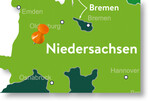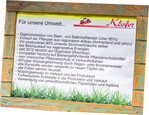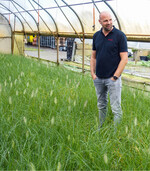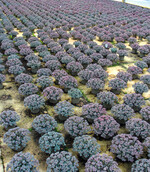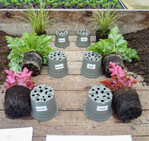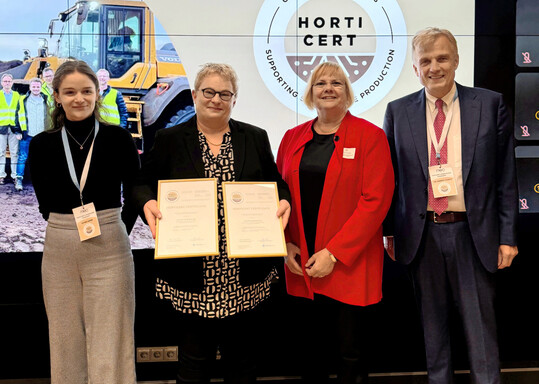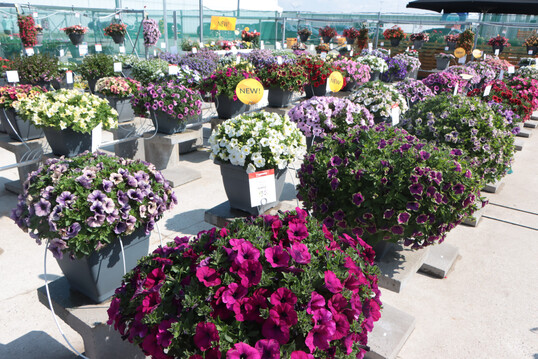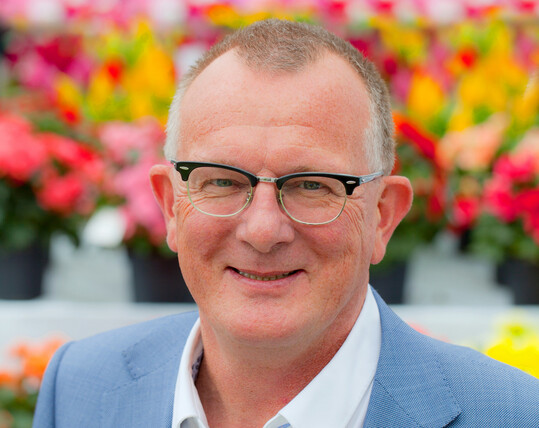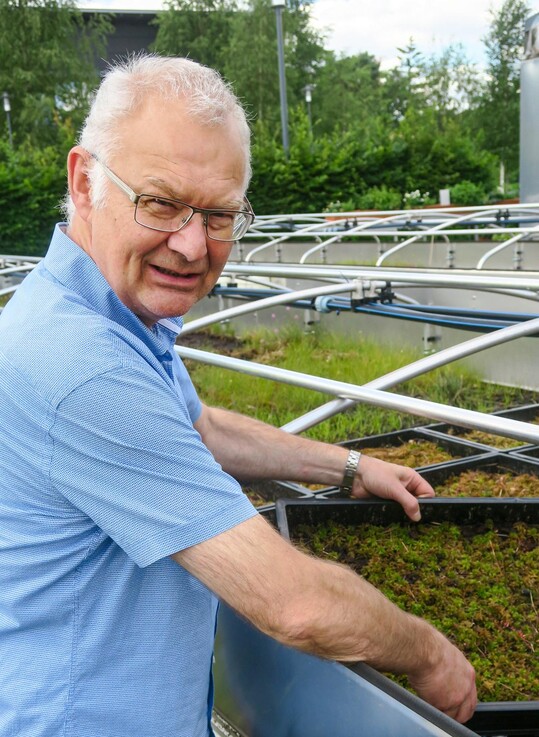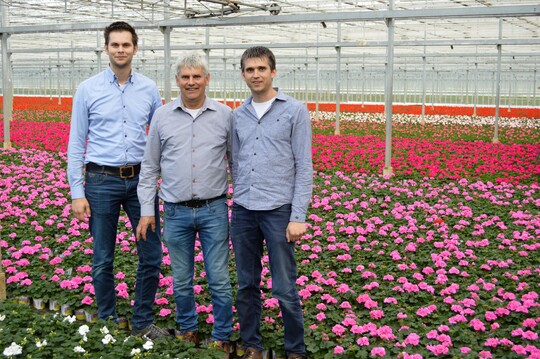Less and less peat
"We always try to switch to ecological technologies or cultivation methods at an early stage," explains Dirk Klefer, who is the third generation to run the retail business. For him and his parents Renate and Hermann Klefer, who are still active in the business, it has long been clear to reduce the use of peat in the nursery.
- Published on
We thought long and hard about whether we should take part in the TerZ model and demonstration project on the use of peat-reduced substrates in ornamental plant cultivation," says Dirk Klefer, who has no regrets about his participation today. Even before the project began, he was using a substrate with around 25% peat substitute. The necessary courage for a further reduction was now provided by the TerZ project. This is because the supervisors take soil samples on the farm at least every four weeks and analyze them.
In the first year of the project, the farm reduced the proportion of peat in the substrate to 60%, and in the second year to 50%. Crop results have been very good, he says. Since 2022, the peat content has been only 40%, both in the production soil and in the sales soil. A substrate on the farm is also sold to private customers. Klefer advertises this, mainly via Facebook.
Soil samples have become important
Although the EC meter always showed an optimum range, the nitrogen content was zero in many cases. Due to the 30% wood fiber content, the N content is quickly consumed. The two different Gramoflor wood fibers serve a stable water balance. The compost used often leads to high potassium values. Today, therefore, more sensitivity is required overall.
Next year, a doubling of the wetting agent addition is planned in order to improve water absorption and distribution. It was particularly noticeable with the grasses that the peat-reduced soil did not absorb as much water as the previous standard substrate.
An earlier admixture of a water granulate in cemetery soils gave good results for the first four months, but afterwards the substrate was significantly drier than without the granulate. This alternative was therefore ruled out.
Klefer's summary on the use of peat-reduced soil: water more with more frequent watering intervals, fertilize more appropriately and carry out more soil tests. The farmer considers participation in the TerZ project to be helpful in trying out many small things and being prepared for the future, in which the use of peat-reduced substrates can no longer be avoided. The peat-reduced substrate is only slightly more expensive than the conventionally used one, he says.
The 800 to 900 hanging baskets need to be watered much more frequently than with the conventional substrate. For this reason, next year's hanging baskets will have a 3 cm larger diameter to hold more substrate. This should make watering easier for customers and keep them happy with the hanging basket plants.
In the medium term, Klefers want to reduce the peat content even further in order to produce and market as climate-friendly and environmentally friendly as possible. The plants purchased are largely sourced from the region. The ecological orientation is also reflected in a forest project. Together with the apprentices, forest was planted on 1 hectare of company land.
As little chemistry as possible
Around 80% of the bedding and balcony plants sold come from the company's own production, as well as many spring-flowering plants, heuchera , grasses and the "Herbstzauber" autumn range. Subsequently, the production houses are completely empty until calendar week 10 in the following year. This has a positive effect on energy costs and plant protection, as most pests are eliminated over the winter.
Plants with low temperature requirements, such as sedum, don't really do well when grown in the older glazed greenhouse, and coloration is not optimal. "So we have the luxury of actually leaving the house empty over the summer," Klefer explains.
Among other plants, Pennisetum are cultivated in the foil houses without chemical pesticides. Cultivated in small pots, they are well suited for bowl plantings. The large 14-cm pots fit the pallet of 8. Watering is done twice a day, which is usually enough even on warm days.
When selecting varieties, Klefers emphasize short cultivation times and compactness to produce without inhibitors.
Good cultivation experience in the foil house
In 2004, the Klefer family had the latest foil greenhouse with EVA double foil built by greenhouse builder Richel, after Dirk Klefer returned from master school and there was one more family member to feed. Even before that there were good culture experiences under foil. The coloration of leaves and flowers is very good and the climate control is good to design. At least 15 years the foil should last. The foil house is as energy-efficient as a single-glazed greenhouse with a simple energy screen, explains Dirk Klefer. The advantage in summer is the large roof ventilation and the side ventilation that can be opened completely.
Here grasses such as Carex and Pennisetum , also Sedum reflexum , Heuchera , Hebe , Santolina , Alternathera , Lysimachia and Euphorbias are cultivated on the ground. The first set in the front part of the house is in peat-reduced TerZ substrate, plants in the back part of the greenhouse are potted in conventional standard substrate. The plant quality is comparable, also the watering intervals are similar. The TerZ soil proved to be super after a minor water damage with flooding in the house, as the pots dried again quite quickly. Due to the fast drying substrate surface of the peat-reduced substrate, there are few fungus gnats and also less fungal infestation.
Three different types of irrigation are found in this house: flow irrigation with a 2% slope, drip irrigation in the middle, and a nozzle irrigation on the right side to accommodate as many plant species as possible. From today's perspective, flow irrigation throughout the house would have been sufficient.
The 250-m³ rainwater tank built three years ago is fed by the new house. Only twice this year did it have to be fed for sufficient watering of the plants. Plans are underway to add another rainwater catchment tank for the front, older greenhouse section to collect even more water and better cope with upcoming longer dry periods and heavy rain events.
In calendar week 18, an additional set of summer flowers such as Sanvitalia, Euphorbia 'Diamond Frost' and partly other species will be potted for summer sale.
The Alternathera, which look like they were treated with inhibitor, were cultivated without any chemicals at all, just cut back once. "We try to use as few chemical pesticides as possible," Klefer said. The use of beneficial insects is sometimes difficult with the summer flowers, which are cultivated in fairly cool conditions.
Grave care becomes more important
While 90% of sales come from retail, 5% come from wholesale and 5% from grave care. Almost 200 graves at eleven cemeteries are cared for. This pays off because several cemeteries can be connected in one trip. Many Euphorbia 'Diamond Frost', myrtles and thyme from own production are planted.
Grave care in the rural area is increasing, contrary to the general trend, because it was not common here in the past. Trusts were still few and far between in the area.
In addition to the range of cut flowers in the sales area already created by the grandparents, there is the mourning corner with a larger meeting table. According to the motto "you should also show what you can do", the finished funeral floristry placed here until collection has proved to be enormously effective in advertising and also shortens the funeral discussions, as customers can see directly what their finished piece could also look like.
The CHP is very worthwhile - the heat pump is being tested
For about ten years, a combined heat and power (CHP) unit with 11 kW of electrical output and 28 kW of heat output with buffer storage has been heating the nursery. "If I had known how lucratively this heating system would run, I would have decided on it a few years earlier," comments Klefer. The CHP runs without interruption from September to March, and only a few hours a day over the summer months. Around 80 % of the electricity is used by the plant itself, and only a small amount has to be purchased. The 11 kW are only exceeded at special times, such as the Advent exhibition with additional electricity consumers, such as the mulled wine sales.
The peak load in winter is absorbed by a gas boiler. In case of emergency, an oil tank is available to be prepared for all eventualities during this uncertain time. Currently, the offer for a heat pump is pending. Then the calculations will be recalculated.
Linking production and sales
The business, which has gradually grown since it was founded by the grandparents of the current owner and master gardener, Dirk Klefer, still has old greenhouses that are embedded in the ground up to 50 cm. The high glass greenhouse built in 1990 for the production of summer flowers was complemented in 1996 by the construction of the entrance area with automatic door to connect production and sales. In the meantime, the house advanced to a sales house. Since the beginning of the pandemic, the back side has been partitioned off for customers in the off-season with light gray, inconspicuous-looking fabric made of thick theater fabric, in order to reduce the size of the sales area and to have to heat less area. Depending on how the energy situation develops, the partition could be placed further forward to the sales area to save more heating energy.
A very good decision in 2005 was the opening of a branch at Edeka-Neukauf in Augustfehn as a shop-in-shop system. This increased total sales by 25% in the very first year. To date, the turnover in this branch is 25% of the operating turnover. No customer losses have been recorded in the retail store. The range of products on offer differs from that of the retail store only in terms of additional bundled goods such as tulips or roses. Since Edeka is already open from 7 a.m. on six days of the week, it was possible to reduce the opening hours in the retail store, which now only opens at 9 a.m. The store is now open from 7 a.m. onwards. The Edeka store, which has its own checkout system, is staffed by two people on a rotating basis.
Fewer bedding and balcony plants next year
Bedding and balcony plants, some of which have one and a half times the greenhouse capacity, will be marketed directly in their entirety. The quantities of heuchera and grasses are too large for direct marketing. A wholesaler in Westerstede therefore takes over batches of plants, for example in four-color Heuchera mix boxes. Everything is marketed in environmentally friendly palettinos. Cultivation takes place in recyclable gray PCR pots.
The nursery plants offered for sale come from nearby nurseries. Green plants are ordered online from the Netherlands and delivered by truck. Klefers still observes too few ecological ways with green plants. Most green plants are still marketed in plastic pallets and wrapped in foil.
Challenging are the many construction sites that cannot be dealt with by the company itself, such as the energy situation, the availability of operating resources or the uncertain purchasing behavior of customers. There remain individual attempts to counteract this, as with heating, but ultimately no one knows what the future will bring.
In the coming year, fewer bedding and balcony plants are to be produced. Many customers simply lack the money for the luxury good ornamental plants, Dirk Klefer soberly analyzes the situation. In 2021 and 2022, necessary price increases were possible. The current inflation hardly allows for further necessary price increases.
Away from paper
In the past, handwritten notes were often no longer legible. The new proprietary order app, for which the digital bonus from the state of Lower Saxony could be used, enables quick and easy entry of telephone orders, for example. Online, the data can be transferred immediately to write the invoice.
The trainees, two florists and one gardener, manage a shift alone in the Edeka store in their third year of training, including daily accounting and depositing money at the bank. This boosts their self-confidence and gives them even more work experience.
Participating in "Boys' and Girls' Day" is also rewarding. Students tie a bouquet and plant a basket or bowl for themselves. This goes down extremely well.
Company data: Klefer nursery, 26689 Augustfehn, Germany
- History: Founding of the company in 1951 by Grete and Hermann Klefer, 1975 construction of the present cut flower store, handover of the company to Renate and Hermann Klefer jun., construction of a 100 m² sales greenhouse, from 1985 new construction of foil tunnels and glass greenhouse for the production of summer flowers, 2000 purchase of land for the expansion of the outdoor sales area and an extension of the parking lot, 2004 1350 m² double foil house for the production of summer flowers and autumn magic.
- Employees: Klefer family plus 7 employees and 3 trainees (2 florists, 1 gardener)
- Crops in production: violas, bedding and balcony plants, vegetable plants, grasses, other perennials, autumn assortment
- Production area: about 2.500 m²
- Sales area: inside about 700 m², outside about 700 m²
- Contact: Blumen Klefer, Stahlwerkstr. 79 26689 Augustfehn, phone 04489 1442, www.blumen-klefer.de; info@blumen-klefer.de



